DRESDEN FRAUENKIRCHE
Baroque Crown Jewel Church Reborn
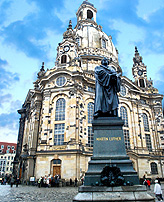 In
the closing days of WWII, as Allied Forces were crossing the Rhine
and the Russians
were pressing in
on the east of Germany, British RAF
Bomber Command carried out a raid on Dresden in Germany Saxony that
would be shocking and lasting to this day. Dresden was one of Europe’s
great Baroque cities, sometimes referred to as the “Florence
on the Elbe River”. Commencing on the night of February 13, 1945,
British Lancasters dropped 375 tons of incendiary bombs and 500 tons
of high explosive and “block buster” bombs on the center
of Dresden. The raid was intended air the Russian advance and
In
the closing days of WWII, as Allied Forces were crossing the Rhine
and the Russians
were pressing in
on the east of Germany, British RAF
Bomber Command carried out a raid on Dresden in Germany Saxony that
would be shocking and lasting to this day. Dresden was one of Europe’s
great Baroque cities, sometimes referred to as the “Florence
on the Elbe River”. Commencing on the night of February 13, 1945,
British Lancasters dropped 375 tons of incendiary bombs and 500 tons
of high explosive and “block buster” bombs on the center
of Dresden. The raid was intended air the Russian advance and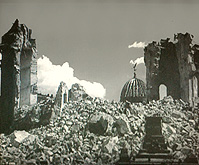 “cause
great confusion in civilian evacuation and hamper movement of reinforcements
from other fronts" according to a memo, but also to demonstrate
the capabilities of the British RAF to the mistrusted allies from the
east. The central target of the first wave was an athletic field next
to the Altstadt (old town). The high explosives bombs fell first to
blow off the roofs, doors, and windows of buildings creating an air
flow that
would feed the fires of the incendiaries bombs. Up to then, Dresden,
was the last large un-bombed city of Germany (see Berliner
Dom Cathedral).
After three nights of fire-bombing, one of Europe’s most beautiful
cities was reduced to black rubble.
“cause
great confusion in civilian evacuation and hamper movement of reinforcements
from other fronts" according to a memo, but also to demonstrate
the capabilities of the British RAF to the mistrusted allies from the
east. The central target of the first wave was an athletic field next
to the Altstadt (old town). The high explosives bombs fell first to
blow off the roofs, doors, and windows of buildings creating an air
flow that
would feed the fires of the incendiaries bombs. Up to then, Dresden,
was the last large un-bombed city of Germany (see Berliner
Dom Cathedral).
After three nights of fire-bombing, one of Europe’s most beautiful
cities was reduced to black rubble.
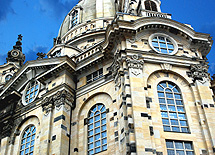 Much
of Dresden’s old city has been rebuilt in a pristine approximation
of the Baroque city it had once been. The parts that remain of the
original ornate Imperial Age architecture are still covered in a charcoal
black
soot, giving a visitor a strange urge to grab a local citizen on the
street and offer up a feeble “About the bombs, really sorry.” But
rather than feel sorry for themselves the citizens of Dresden set
about to recreate their city.
Much
of Dresden’s old city has been rebuilt in a pristine approximation
of the Baroque city it had once been. The parts that remain of the
original ornate Imperial Age architecture are still covered in a charcoal
black
soot, giving a visitor a strange urge to grab a local citizen on the
street and offer up a feeble “About the bombs, really sorry.” But
rather than feel sorry for themselves the citizens of Dresden set
about to recreate their city.
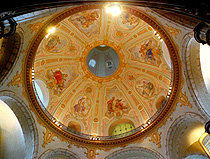 The crown
jewel of Dresden’s rebirth is the Frauenkirche in the
center of the Altstadt, once the most impressive stone domed church north
of the Alps. Not as large as earlier Cathedrals, but of that purely Baroque,
square form dominated by its towering central dome with the seating inside
in balcony decks more like a concert hall. Original construction
of Dresden’s
Frauenkirche was completed in 1743 with its consecration celebrated
with an organ
concerto
performed
by
Johann Sebastian Bach.
One hundred Years later in 1843 Richard Wagner conducted the first performance
of his “Feast of the Pentecost” under the Frauenkirche’s
great dome. Then, in another hundred years the bombs fell. The blackened
gutted ruins of the church stood for two days before completely collapsing.
Reconstruction of the Dresden’s symbolic church was first suggested
in the days following the end of the war, but under the East German socialist
GDR, the ruins remained a pile of untouched rubble. After the fall of
the Berlin Wall (see Berlin Wall Museum) in 1989 the idea of reconstruction
was renewed. Archeological recovery began in 1994 with ten years of painstaking
rebuilding, with a new cross for the dome cupola presented as a gift
from the people of Great Britain, replaced on the spire in 2004. The
Frauenkirche was re-consecrated on October 30 of 2005.
The crown
jewel of Dresden’s rebirth is the Frauenkirche in the
center of the Altstadt, once the most impressive stone domed church north
of the Alps. Not as large as earlier Cathedrals, but of that purely Baroque,
square form dominated by its towering central dome with the seating inside
in balcony decks more like a concert hall. Original construction
of Dresden’s
Frauenkirche was completed in 1743 with its consecration celebrated
with an organ
concerto
performed
by
Johann Sebastian Bach.
One hundred Years later in 1843 Richard Wagner conducted the first performance
of his “Feast of the Pentecost” under the Frauenkirche’s
great dome. Then, in another hundred years the bombs fell. The blackened
gutted ruins of the church stood for two days before completely collapsing.
Reconstruction of the Dresden’s symbolic church was first suggested
in the days following the end of the war, but under the East German socialist
GDR, the ruins remained a pile of untouched rubble. After the fall of
the Berlin Wall (see Berlin Wall Museum) in 1989 the idea of reconstruction
was renewed. Archeological recovery began in 1994 with ten years of painstaking
rebuilding, with a new cross for the dome cupola presented as a gift
from the people of Great Britain, replaced on the spire in 2004. The
Frauenkirche was re-consecrated on October 30 of 2005.
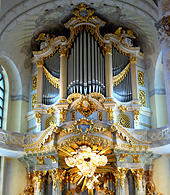 The rebuilt church in light-colored stone stands in the center of the
square with a statue of Martin Luther in front and surrounded by the
shops and restaurants of the rebuilt old city. The rebuilding design
was taken from the original plans which fortunately survived. Some of
the fire blackened original stones recovered are placed among the mostly
new stones, meticulously mapped, marked and placed in their original
position, rather like a massive jigsaw puzzle, giving the surface a curious
checkerboard look, but a permanent reminder of its history.
The rebuilt church in light-colored stone stands in the center of the
square with a statue of Martin Luther in front and surrounded by the
shops and restaurants of the rebuilt old city. The rebuilding design
was taken from the original plans which fortunately survived. Some of
the fire blackened original stones recovered are placed among the mostly
new stones, meticulously mapped, marked and placed in their original
position, rather like a massive jigsaw puzzle, giving the surface a curious
checkerboard look, but a permanent reminder of its history.
Visiting Dresden's Frauenkirche
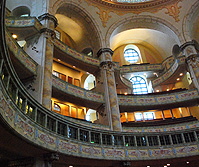 Entry to
the church is free, though donations are encouraged. Audio guides in
six languages
can be rented for €2.50. Visitors are invited
to attend services on Sundays and public holidays. For other times “Open
Door” hours are 10am – 12pm and 1pm - 6pm Monday to Friday.
Guided tours for small groups can be arranged on the day. Organ and choir
concerts are given on Saturdays at 8pm and every other week on Sundays
at 3pm and Wednesdays at 8pm. For a closer look at the story of the church’s
rebirth, Dresden’s City Museum, the Landhaus, two blocks away,
presents an exhibition on the History, Reach and reconstruction of the
Frauenkirche. A 25 minute film on “The Fascination of the Frauenkirche” is
presented in the Visitor Center in the Kulturpalast on Galeriestraße.
Dresden’s Altstadt is about three tram stops from the Dresden main
rail station, to either the Altmarkt or Pirnaischser Platz. © Bargain
Travel Europe
Entry to
the church is free, though donations are encouraged. Audio guides in
six languages
can be rented for €2.50. Visitors are invited
to attend services on Sundays and public holidays. For other times “Open
Door” hours are 10am – 12pm and 1pm - 6pm Monday to Friday.
Guided tours for small groups can be arranged on the day. Organ and choir
concerts are given on Saturdays at 8pm and every other week on Sundays
at 3pm and Wednesdays at 8pm. For a closer look at the story of the church’s
rebirth, Dresden’s City Museum, the Landhaus, two blocks away,
presents an exhibition on the History, Reach and reconstruction of the
Frauenkirche. A 25 minute film on “The Fascination of the Frauenkirche” is
presented in the Visitor Center in the Kulturpalast on Galeriestraße.
Dresden’s Altstadt is about three tram stops from the Dresden main
rail station, to either the Altmarkt or Pirnaischser Platz. © Bargain
Travel Europe
Find best hotel and vacation deals in Dresden on TripAdvisor
Web Info
Frauenkirche
These articles are copyrighted and the sole property of Bargain Travel Europe and WLPV, LLC. and may not be copied or reprinted without permission.
See Also:
SOPHIENKELLER - BAROQUE THEME RESTAURANT
BAROQUE
CHURCHES OF MUNICH
WORMS
CATHEDRAL AND MARTIN LUTHER
NEUES MUSEUM BERLIN - EGYPTIAN COLLECTION
SLEEPER TRAIN FROM DRESDEN TO ZURICH

